Specimens
4,400,000

Acanthacorydalis fruhstorferi is the largest dobsonfly in the world and is found in eastern China and northern Vietnam. The males have large mandibles (jaws), which are used when competing with each other for females. The males will try to place their mandibles underneath the body of the opponent in order to flip him into the air.
An eclectic collection of 24 orders of insects and their close relatives within Hexapoda.
4,400,000
98,000
45,000
While each order within the small order collection is not as species-rich as the four remaining insect orders (Coleoptera, Hymenoptera, Diptera and Lepidoptera), when combined, the small orders account for over 190,000 known species. The group exhibit a tremendous diversity of ecological and life-history traits resulting from over 400 million years of evolution.
Each order has different geographic strengths due to the interests of various experts working in these groups over the collection’s almost 300-year history.
The collections generally have better coverage of the fauna of Europe, sub-Saharan Africa, Southeast Asia and Australia. The collections are being actively developed through external donations and field expeditions with local collaborators in under-represented or particularly biodiverse areas.
In addition to specimens collected by Charles Darwin and Alfred Russel Wallace, the collections comprise material collected and described by William Dallas, Francis Walker, William Distant, Frederic Charles Fraser and Rev. Alfred Eaton, among many other entomologists.
Diana Rendón Mera
Dan Hall
Hemiptera, Orthoptera, Phthiraptera (now within Psocodea), Trichoptera, Odonata and Mantodea are particularly well represented within the collection and contain over half the currently known species.
185,000
1,650
1,500
The primitive hexapods, some previously included in the Apterygota, are a paraphyletic grouping of insects and their close relatives with no wings, comprising almost 10,000 known species in the Collembola (springtails), Diplura (two-pronged bristletails), Microcoryphia (jumping bristletails), Protura (coneheads) and Zygentoma (silverfish and firebrats).
The Collembola, or springtails, are small (0.25 to 6 millimetres long) and currently recognised as a sub-class within Hexapoda, containing over 6,000 described species. Springtails are aptly named after a unique forked structure attached to their abdomen called a furculum. The furculum is usually held under tension. When released, it springs against the surface, propelling the springtail up to one hundred times its length. Springtails are omnivorous and prefer moist conditions. The Museum’s collection comprises both spirit preserved and microscope slides.
The Diplura, or two-pronged bristletails, are an order consisting of 800 currently described species. They are elongated and small, from 2 to 7 millimetres in length. They are hemimetabolous, live in moist habitats and feed on dead organic matter. Some species are known to be predatory and have pincer-like mouthparts to capture prey. The Museum’s collection is primarily preserved in spirit or as microscope slides.
The jumping bristletails, previously known as the Archaeognatha, are an order consisting of 350 known species. Bristletails have small elongate bodies, large compound eyes, and three tails. Much of their body is covered with flat scales giving the bristletails a shiny appearance. They are known to live up to four years, feeding primarily on algae, lichens, mosses and decaying organic detritus. They are very active and can jump up to 30 centimetres using their tails! The Museum’s collection is primarily prepared as microscope slides.
The Protura are an order of simple hexapods consisting of approximately 800 described species. The Protura are very small, being 0.6 to 1.5 mm long, and have no eyes or antennae but can sense their surroundings through their front legs. They have rudimentary mouthparts and feed on decaying organic and fungal matter. The Museum’s collection is preserved in spirit or as microscope slides.
The Zygentoma, previously known as the Thysanura, contains the groups commonly known as silverfish and firebrats. They are similar to the Microcoryphia with three tails but do not jump. The Zygentoma have elongated bodies 7 to 19 millimetres in length. Silverfish are aptly named after their shiny scales, which the firebrats lack. They are often found in domestic environments, feeding on cereals, starch, paper, fabrics and dried meat. The Museum’s collection is primarily preserved in spirit or as microscope slides.
The major historical collections within these groups are the C. Börner collection of 853 identified specimens, including much of his type material which was added to the Museum’s collection in 1907. A.D. Imms added further important collections in 1912. H. Womersley first worked on the collection in the 1930s, and F.G.M. Westropp compiled the first full species index. Peter N. Laurence greatly enhanced the collection from 1954 during his 35 years of Museum service. R.S. Bagnall’s collections were added in 1959. Much material was added in this period by using the new Berlese funnel collecting method.
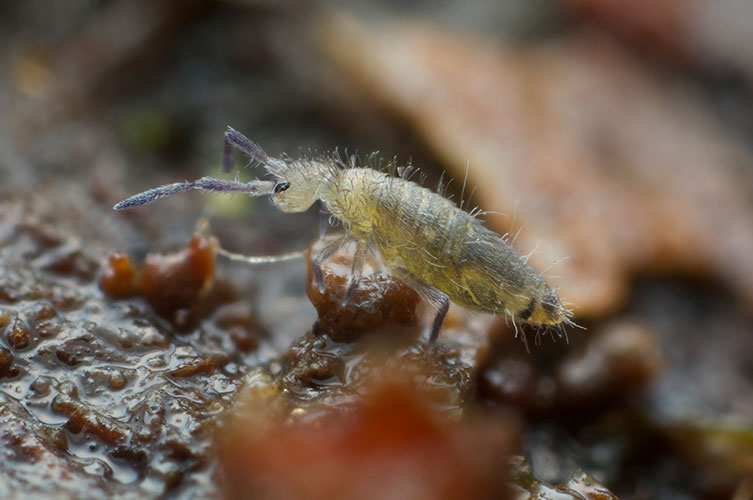
Springtails (class Collembola) are abundant hexapods that feed on decaying vegetation.

Clover springtail, Sminthurus viridis (Linnaeus, 1758)

Two-pronged bristletail, Campodea fragilis (Meinert, 1865)

The sea bristletail, Petrobius maritimus, Appledore, Devon 26.vii.2021

Conehead, Acerentomon affine (Bagnall, 1912)
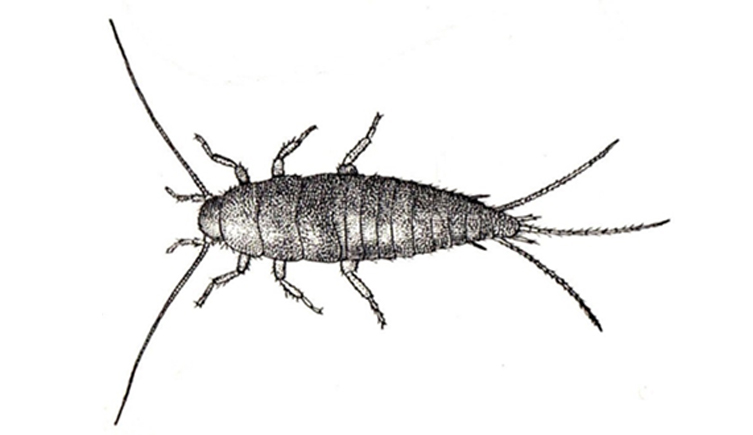
The Silverfish (Lepisma saccharina L.)
The Museum’s Blattodea collection combines both the cockroaches and the termites, now considered a single order. There are 7400 known species of cockroach and termite. The cockroaches are not colonial but tend to aggregate and may be considered pre-social, and all adults are capable of breeding. Though the majority of cockroaches produce and deposit oothecae (egg cases), the Blaberidae are ovoviviparous, having the ootheca retained within the abdomen until birth, with a few specialised genera showing brooding behaviour or short-term parental care and others showing subsocial behaviour, first instar nymphs being protected and fed whilst clinging to the female parent. In the wood-feeding Cryptocercidae, closely related to termites, adults excavate galleries and keep them clean, maintaining contact with their offspring for some time. Termites are eusocial and have a caste system within each colony, with a pair of mature reproductives, the king and the queen, and many sterile workers and soldiers.
Cockroaches are known mainly for the very few species which are notorious as domestic pests. Over 99% of cockroaches are wild living with many attractive and impressive species.
343,000
3,200
1,200

The cave cockroach, Blaberus giganteus, is one of the largest known species of cockroach.
The Dermaptera, commonly known as earwigs, are an order of insects with 2,000 known species. While a common misconception is that they are named after their habit of crawling into our ears, it is generally agreed that the name originates from the shape of the hindwing, which resembles a human ear when unfurled. Earwigs are characterised by a pair of large forceps-like pincers on their abdomen, which are used to assist with wing folding, prey capture and defence. They are also one of the few non-social insects which show maternal care of the developing eggs and very young nymphs. Two small groups of earwigs are considered to be commensal or ectoparasitic: the Arixeniidae live with bats in caves in Borneo, and the Hemimeridae are ectoparasitic, living in the fur of African giant pouched rats. Both groups have developed viviparity, offspring developing in a uterus in the female.
22,000
1,000
550
The St. Helena earwig is the largest known species, reaching a length of approximately 8cm. Endemic to the island of St. Helena, the earwig has not been seen alive since 1967 despite numerous searches for it. As a result, this species has been listed as extinct by the IUCN. The Museum’s collection includes two specimens from a Belgian expedition in 1965.

The St Helena giant earwig, Labidura herculeana, is the world’s longest earwig.
The order Embioptera (also known as Embiidina) or webspinners are a fairly small group with around 460 known species, although it is estimated that over 2000 species currently exist in nature.
Their common name comes from the group’s unique ability among insects to spin silk from structures on their front legs, used to make the web-like gallery in which they live. Webspinners are found mainly in tropical regions, however, they also extend into the temperate parts of the United States and southern Europe.
2,300
420
98
The Ephemeroptera, or mayflies, are an ancient order of freshwater insects dating back to the Carboniferous with 3,340 known species.
Larval mayflies live in both standing and running water and along with stoneflies, caddisflies and several other invertebrate groups, are used to assess water quality due to their differing tolerance to pollutants.
Mayflies are unique among insects because they have two adult stages with wings. The first adult stage, called a subimago, assists with the transition between freshwater and terrestrial environments, while the second stage, the mature imago, is the breeding stage. The adult stage of most mayfly species is very short, frequently less than a few days and in some mayfly species, the adult stage is so short that the subimago has become the sexually mature final life stage.
Some mayfly species exhibit a synchronised mass emergence of the adults in numbers so great they can be seen on weather radar and result in blizzard-like conditions, covering roads and vehicles which they mistake for water.
35,000
840
670
The Museum’s Ephemeroptera collection includes historical material from Rev. A.E. Eaton, who joined the Challenger Expedition (1872-1876) and the Transit of Venus Expedition (1874-1875) as a naturalist.
The Martin Mosely collection of sealed watchglasses contains many good examples of freshwater insects, including several mayflies. More recently, the substantial collection of Mick Gillies, containing many species from sub-Saharan Africa, was added to the collection and has been digitised as part of ongoing recuration in the order.

A giant tusked mayfly (genus Proboscidoplocia) from Madagascar.

A mayfly adult while in the process of moulting between the winged subimago and imago stages.

The type specimen of Hexagenia illustris, a burrowing mayfly collected from Uganda.
The Museum’s Hemiptera (true bug) collection is among the largest and most important in the world for its geographical coverage and primary type holdings and is an unparalleled reference collection.
The collection is divided into two curatorial groups:
2,800,000
52,000
22,500
The Heteroptera are a diverse group of bugs, including terrestrial assassin bugs, plant bugs, bedbugs, leaf-footed bugs and shield bugs, and the aquatic backswimmers, water scorpions and water boatmen. The group is so named for their 'different wings' in which the forewings of most species are part hardened into a hemelytra.
The Auchenorrhynca comprise the cicadas, leafhoppers, treehoppers, planthoppers, and spittlebugs. All members of this group are plant-feeders, and many are vectors of viral and fungal diseases of plants. Many species of Auchenorrhynca produce either audible sounds (e.g. the loud summer songs of cicadas) or substrate-borne vibrations as a form of communication.
The Coleorrhyncha, also known as moss bugs, are a very small suborder of flightless Hemiptera that represent an ancient lineage of moss-feeding insects associated with the distribution of Nothofagus (southern beech) trees in Australia, New Zealand, New Caledonia, and South America.
The Sternorrhyncha are a moderately large group of approximately 18,000 species. These plant-feeding bugs, including the well-known aphids, whiteflies, jumping plant lice and mealybugs, are divided into four superfamilies.
The Aleyrodoidea (whiteflies) are tiny moth-like insects covered with secreted white wax particles, with nymphs that are immobile and thus remain in one spot through their entire pre-adult life. The taxonomy of species is based on the immatures as adults are mostly identical. Mostly tropical, they are pests of glasshouse crops in Britain.
The Aphidoidea (aphids, greenfly and blackfly) are soft-bodied, sap-suckers that have both sexual and non-sexual parthenogenetic generations. Aphids tend to form in clusters and prefer young shoots and succulent leaves. Many species are host specific, and some are pests of food crops and can be vectors of plant viruses. They are mostly found in temperate regions, and the Museum’s collection is strongly representative of the Western Palearctic and Nearctic regions.
The Coccoidea (scale insects and mealybugs) are a small group of plant parasites. Females are either completely immobile or have limited mobility, whereas males mostly have wings but no feeding mouthparts, meaning they typically die within a few days. Mostly tropical, they can be problematic for food crops and house plants in Britain.
The Psylloidea (jumping plant lice) have life-cycles nearer to being 'typical' for Hemiptera in that they have mobile nymphs with well-developed legs and robust adults with four wings. They are both temperate and tropical in distribution.
The Hemiptera collection contains all of the early William Dallas and Francis Walker types and most of William Distant’s types. In addition, the initial collections of F. V. Theobald, G. B. Buckton, and J. P. Doncaster were greatly increased by the acquisition of the Henry Stroyan’s British collection in 1982 and Hille Ris Lambers’ world collection in 1984 and were further added to by Victor Eastop and Roger Blackman. David Hollis greatly increased the Psylloidea collections in the latter half of the 20th Century.
This mainly old-world material is complimented by Biologia Centrali-Americana specimens and types, making the collection a truly global resource. Recently the whole psyllid, aleyrodid, and coccid microscope slide collections have been imaged in the Museum’s Digital Collections Programme.
Heteroptera, Auchenorrhynca and Coleorrhyncha
Sternorrhyncha

Whitefly Lecanoideus floccissimus adult (Martin, Hérnandez-Suarez & Carnero, 1997)

Aphid, Amphorophora tuberculate (Brown & Blackman, 1985)

The mealybug, Phenacoccus manihoti, (Matile-Ferrero, 1977) is a major pest on cassava crops.
The order Mantodea, more commonly called the praying mantises due to their upright posture and bent raptorial forearms, is the sister group to the cockroaches and termites, with over 2,500 known species. Mantids are voracious predators of other arthropods and possess the first confirmed stereo vision outside of vertebrates. Night-flying winged mantids also possess a ventral abdominal ear which enables detection of ultrasound and hence avoidance of echolocating bats.
Many mantids are green and live in bushes so well camouflaged, other species may be bark-like or straw-coloured in similar habitats, and the early stages are often very different. For example, in the orchid mantis, Hymenopus coronatus, the nymphs may be white or pink and blend perfectly with orchid flowers.
29,000
1,200
480

A praying mantis from the collection.
The order Mecoptera includes groups known as scorpionflies, hangingflies and snowfleas, with approximately 770 currently known species. The order is closely related to the flies (order Diptera), and recent evidence suggests the fleas (order Siphonaptera) are most closely related to the snowfleas and should be placed within Mecoptera. In some groups, the female chooses the male based on the quality of the prey item offered up as a gift during mating.
6,000
220
100
The order Megaloptera includes the dobsonflies, alderflies and fishflies. The order is not very diverse, with only 380 known species globally. Megaloptera larvae are voracious underwater predators, however, the adults are short-lived and typically feed on nectar, if at all. The males of some species develop impressive mandibles used in courtship.
3,500
170
100

The Asian dobsonfly Acanthacorydalis fruhstorferi is the largest freshwater insect with a wingspan of up to 21.6cm.
The order Neuroptera, comprising the lacewings, mantidflies and antlions, comprises 6,000 species currently known to science. The larvae are predators, often eating aphids which have resulted in their use for the biological control of pests. The larvae of some species build conical pits in sandy areas to trap insects such as ants, earning them the name 'antlion'.
The elongated hindwing of some crepuscular spoonwing species is thought to be a distracting lure for hunting bats, similar to the trailing hindwings of some moths. By luring the bat away from the body, the spoonwing can survive being attacked and fly away relatively unharmed.
43,000
2,400
1,060
The significant collection of Robert McLachlan, some 50,000 Neuroptera and Trichoptera, was donated to the Museum and incorporated by Mosely and Douglas Kimmins.
The order Notoptera, meaning no wings, is a group which includes the wingless ice crawlers (previously order Grylloblattodea) and gladiators or heelwalkers (previously order Mantophasmatodea). There are only 57 known species in the group. As their name suggests, the ice crawlers live in extremely cold environments at the tops of mountains and the edges of glaciers and live in a very narrow temperature window of 1 to 4°C. Gladiators, on the other hand, are found in the hot climates of Namibia and South Africa.
The first known ice crawler was described in 1914 from Canada, and 34 species are now known from North America and East Asia, the first heelwalker was described in 2002, and 21 species are now known.
13
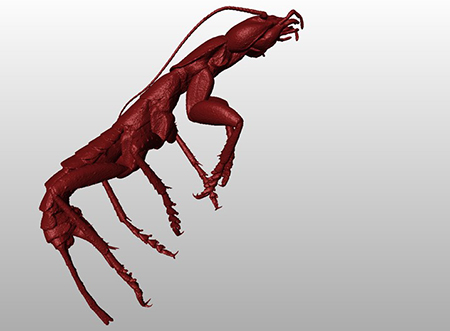
A 3D reconstruction of an ice crawler (Grylloblattidae) specimen using a micro-CT scanner.
The order Odonata, also known as dragonflies and damselflies, is one of the earliest branches of insects and comprises 6,650 known species. They are voracious predators, with a reported 95% hunting success rate as adults, far higher than any other known species. Their freshwater larvae live for up to five years before emerging as winged adults. Dragonflies are unique amongst insects in that their four wings are each independently and directly controlled by flight muscles, making them very agile.
110,000
4,260
1,885
The collection is rich in primary types of species described by Frederic Charles Fraser, Edmond de Sélys Longchamps, William Forsell Kirby, Robin John Tillyard, Robert McLachlan, and Cynthia Longfield. While the collection is relatively comprehensive geographic strengths include Europe, Africa, S.E. Asia (especially India) and Australia.

A display drawer highlighting the diversity of dragonflies and damselflies.

A closeup of the wing of the stream jewel (Neurobasis chinensis).
The Orthoptera are known for their sound production and jumping ability. They may also be recognised by their saddle-shaped pronotum, which extends backwards to cover the thorax and wing bases, often with a median keel or crest.
Orthoptera is divided into two suborders:
The Ensifera, which means sword-bearing, have distinctive, often elongated and blade-like ovipositors (egg-laying organs) and long delicate antennae (feelers), their songs are produced by using their forewings to stridulate, and their hearing organs are near the base of their foretibiae; included are the major group of bush-crickets, also known as katydids in North America, Australia and other countries, with the cave crickets, camel crickets, dune crickets, Jerusalem crickets, and the true crickets and mole-crickets.
The Caelifera, which means chisel-bearing, have short ovipositors like engraving tools and short, sturdy antennae. They produce their songs by scraping their hind legs against raised veins on their forewings, with their hearing organs on the side of their abdomens; included are grasshoppers, locusts, bladder grasshoppers of South Africa, stick or horsehead grasshoppers of South America, monkey grasshoppers and others, groundhoppers and pygmy mole-crickets.
The bush-cricket groups are often crepuscular. Some predatory species have long spines on the fore and mid legs to catch their prey; the mole-crickets have forelegs highly modified for digging.
The grasshopper groups are herbivorous, diurnal, and active in sunny weather.
All orthopteroid insects may show some camouflage. Many look like leaves, bark or grasses. Some grasshoppers show startle or flash colouration, having brightly coloured hind wings which are visible in flight but which disappear when folded away on landing – so the insect may escape notice by predators.
Certain grasshopper species are known as locusts and produce large seasonal outbreaks of millions of hungry insects that may devour vital crops. This is a great risk to agriculture. Both biological and chemical control measures are now utilised.
Globally, there are over 29,000 known species.
378,000
10,500
5,000
In 1996, the Natural Resources Institute (formerly the Anti-Locust Research Centre) presented its collection of over 82,000 specimens of grasshoppers and locusts, mainly identified, which resulted in the expansion of the Acridoidea collection by nearly 50%.
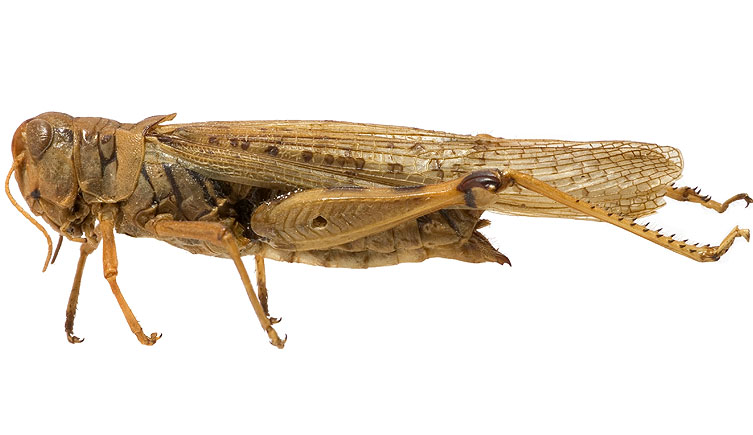
The extinct Rocky Mountain locust, Melanoplus spretus.
The Phasmids, also known as Phasmatodea, are the stick-insects (walking sticks in the USA) and leaf-insects, all herbivorous, usually feeding at night, and many very well camouflaged. Whilst at rest, their twig/bark/leaf/lichen or other appearance renders them almost invisible. Some adults are winged. The males with their longer hindwings and thinner bodies are better at flight and may do so when seeking wingless females; in flight brightly coloured hind wings may be seen. Eggs are seed-like, laid singly and may be carried away by ants, the nymphs later emerging from the ants’ nest. A few species are recorded as pests, particularly in plantations.
Globally, there are over 3,500 known species.
14,000
1,000
410
Since the 1980s, the collection has benefitted greatly from donations of wild caught and culture material resulting from the activities of both amateurs and professionals, including the type specimen of the world’s longest described phasmid, Chan’s Megastick, Phobaeticus chani.

A stick insect specimen seen from the side.
The Plecoptera, commonly known as stoneflies, are a group of freshwater insects with 3,900 currently known species. Larval stoneflies typically live in fast-flowing water and, along with mayflies, caddisflies and several other invertebrate groups, are used to assess water quality due to their differing tolerance to pollutants. Adults will drum on the riverside substrate (e.g. stones, branches) to find a mate with their species-specific beat.
17,000
720
340

Stoneflies (order Plecoptera) are used as indicators of high water quality.
The order Psocodea is an amalgamation of two groups previously regarded as orders, the Phthiraptera (true lice) and the Psocoptera (bark lice or book lice). Globally there are 10,500 known species of Psocodea.
166,000
5,300
3,600
Lice are permanent, obligate ectoparasites of birds and mammals. Three of the suborders (Amblycera, Ischnocera and Rhynchophthirina) are known as chewing or biting lice, and the fourth (Anoplura) forms the sucking lice. There are about 5,000 known species, present in roughly 4,000 species of birds and 800 mammals. Most are highly host-specific, and consequently, lice are present in every continent and virtually every habitat occupied by birds and mammals.
The Museum’s collection began with the acquisition of the Henry Denny collection of 200 species with 90 primary types in 1852. In 1928 the Edouard Piaget collection of 10,000 specimens of European Lice with c. 300 primary Types was acquired. In the 1930s, both the L. Harrison collection and 17,530 James Waterstone slides were added. Theresa Clay worked on the collections from 1935, and in 1951, 58,800 Colonel Richard Meinertzhagen slides, including 1,791 types, were added. In 1961, the G. H. E. Hopkins collection (10,000 slides including 1,500 paratypes) was added to the collection. The most recent addition has been the R. S. Balter slide collection of Louse eggs on 7,000 microscope slides. There is a smaller secondary collection housed in spirit. A major work describing new species from Museum Brueelia specimens was completed by Daniel Gustafsson and Sarah Bush in 2017. Recently the whole louse microscope slide collection has been imaged by the Museum's Digital Collection Programme.
Book lice or bark lice are small (1-10 mm long), soft-bodied, with long antennae and large compound eyes. They feed on lichens, algae, moulds, cereals, pollen and detritus in leaf litter, tree bark and living plants. A few species are pests of stored food products and the starch found in book bindings. There are at least 5,000 known species, and like aphids, many psocids are parthenogenic, and the presence of males may even vary between different races of the same species. The Museum’s collection is equally split into a microscope slide collection, a dry pinned collection and a spirit collection. Dave Hollis greatly added to the collection in the second half of the 20th century.
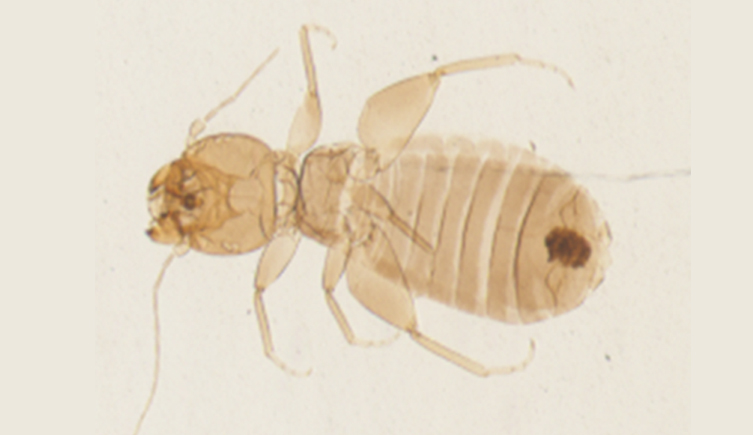
A booklouse, Liposcelis bostrychophilus

A parasitic louse, Felicola hopkinsi(Bedford, 1936 Allotype)
The Raphidioptera, more commonly called snakeflies due to their elongated pronotum (neck), are usually found in temperate coniferous forests. This order was once considered a family within the lacewings (Neuroptera) and while not a particularly diverse group with only 270 known species, they have a long evolutionary history, with fossils found dating back 140 million years which look very similar to the species we find today.
630
68
25

Snakeflies (order Raphidioptera) are named for their long, slender neck.
The Thysanoptera are a group of insects commonly known as thrips. They are small insects, mostly smaller than 1 millimetre, although some species can be over 1 centimetre long. They all share fringed wings and uniquely asymmetrical mouthparts. Thrips mainly eat plant liquids, although some species ingest small fungal spores or are predatory on other small arthropods. Their feeding activity often causes damage to plants, leading to galls and scarring, and they can transmit plant viruses. Globally there are 6,200 known species.
The Museum’s collection consists mostly of microscope slide preparations, mounted using Canada balsam to ensure a good state of preservation. The body contents are cleared using warm Potassium hydroxide to allow light through to study the taxonomic features.
The collection was started by Francis Walker, developed by Fred Laing from 1914 and greatly enhanced by R. S. Bagnall’s collection. Dr Lawrence Mound worked on the collection from 1964 during his 30 years of active Museum service. There are extensive collections from the Americas, Africa, Asia and Australasia.
112,000
3,500
2,200

Phlaeothrips coriaceus (Haliday, 1836)
The Trichoptera, commonly known as caddisflies, are the sister group to butterflies and moths (Lepidoptera), with aquatic larvae and short-lived terrestrial adults. Caddisfly larvae live in both standing and running water, and along with stoneflies, mayflies and several other invertebrate groups, are used to assess water quality due to their differing tolerance to pollutants. Some caddisfly larvae build intricate fixed or mobile cases, using silk to adhere sticks, leaves and stones. These cases are primarily for protection and to assist with respiration in poorly oxygenated waters. Globally there are 15,200 known species.
138,000
10,000
1,900
Martin Ephraim Mosely joined the Museum in 1929 as a Scientific Associate. He worked on the Museum’s Trichoptera collection as well as his significant private collection for 20 years, publishing over 100 scientific papers. Mosely’s collection of 8,000 caddisflies was donated to the Museum upon his death. During Mosely’s unofficial time in charge of the caddisflies, the significant collection of Robert McLachlan, some 50,000 Neuroptera and Trichoptera were donated to the Museum and incorporated by Mosely and Douglas Kimmins.

Caddisflies preserved by Martin Mosely with the vegetation they’ve used for their protective cases.

A caddisfly and its intricate sand-based case.
The Zoraptera, commonly known as angel insects, have a superficial resemblance to termites. The group was named for being wingless (Zor = 'pure' and 'aptera' = wingless) before winged forms were discovered. They are minute insects, less than 3mm long. Under favourable conditions, the wingless form predominates. However, when conditions deteriorate, winged forms are produced that also have compound eyes, presumably to aid navigation to more favourable habitats. Zoraptera feed on fungal spores and arthropod detritus and are gregarious, occurring in colonies under tree bark, in rotting wood, under stones and in termite nests. Globally there are only 45 known species of this very small order.

Zorotypus hubbardi (Caudell, 1918)
35
7
5